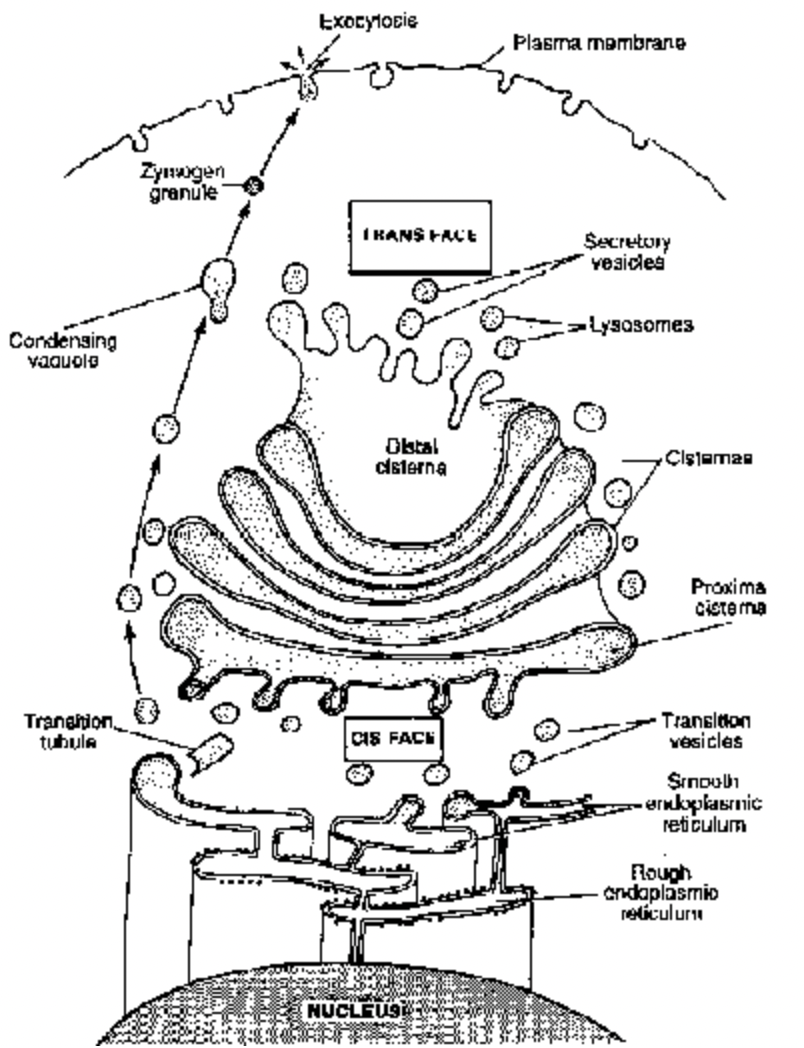Golgi Appratus
Structure of Cell of Class 11
Golgi bodies were first detected in nerve cells of cat and owl by Camillo Golgi (1891).
Found in all cells except RBC of mammals and muscle cells.
Also known as Golgisome, Idiosome or Lipochondria.
In plant cells the Golgi complex consists of many unconnected units known as dictyosomes.
Number varies from cell to cell, secretory cells have most numerous, while muscle cell has none. In plant cells number increases during cell division.
Shape is also variable, from a single vesicle (=dictyosomes in plants) to large network like (in neurons) located between the nucleus and the secretory surface. Dictyosomes are present in large number on two
side of the equator in dividing plant cells.
 Structure
Structure
Morphologically very similar in both plant and animal cells. It consists of dictyosome units formed by stacks of flattened disc-shaped cisternae and associated secretory vesicles.
A single large structure that occupies a definite position between the nucleus and the pole of the cell. Appears to be surrounded by a zone from which most ribosomes, glycogen and mitochondria are absent, known as zone of exclusion.
Three membranous components recognised under the electron microscope are (1) flattened sacs (i.e. cisternae); (2) clusters of tubules and vesicles of about 60 nm; and (3) larger vacuoles filled with an amorphous or granular content.
The Golgi cisternae are arranged in parallel and are separated by a space of 20 to 30 nm, which may contain rod-like elements or fibers.
Often the cisternae are arranged concentrically with a convex and a concave face. There may be from 3-7 of these structures in most animal and plant cells. In certain algae, however, there may be as many as 10 or 20 cisternae.
Each stack of cisternae forming a dictyosome is a polarized structure having a proximal or forming face generally convex and closer to the nuclear envelope or the ER and a distal or maturing face of concave
shape that encloses a region containing large secretory vesicles. This polarization is often referred to as the cis-trans axis of the Golgi complex.
The cis or forming face is characterized by the presence of small transition vesicles or tubules that converge upon the Golgi cisternae.
Associated with the trans or maturing face there is often a saccular structure that is rich in acid phosphatase and has been called the GERL. It has been interpreted as a region of smooth endoplasmic reticulum, near the Golgi, which is involved in the production of lysosomes.
Origin of Golgi Body from ER
Golgi cisternae arise from the RER. The ER releases small vesicles called transition vesicles. They are rich in proteins, enzymes, and various secretory products and show polarity. These vesicles become flat
and fuse together to form the forming face (or cis) of the Golgi cisternae. The older cisternae come on the maturation (trans) face. The forming face points towards the nucleus while the maturing face points
towards the exterior of the cell.
Functions of the Golgi Apparatus
Glycosidation of lipids and proteins to produce glycolipids and glycoproteins.
Cell secretion, not only of exportable proteins but also of the enzymes present in lysosomes and peroxisomes.
Formation of primary lysosomes. A number of lysosomal enzymes are glycoproteins and are glycosidated at the Golgi complex.
Packaging of proteins, trimming, sorting and condensation is done here into secretory vesicles for exporting or storing.
Synthesis and secretion of polysaccharides.
Lipid packaging and secretion.
After releasing its content outside, membranes of the vesicles are integrated into the plasma membrane.
It synthesizes hemicellulose and pectic groups of polysaccharides especially during cell division. These substances are laid down on the cell plate. Dictysosomes contain a pool of precursors for the synthesis of
cell wall materials but they are not involved into the synthesis of cellulose itself.
- Introduction of Cell
- Concept of Protoplasm
- Theory of Cell
- Cell organization
- Cell Size
- Cellular Totipotency
- Types of Cell
- Flow of Information
- Structure of Cell
- Cell Membrane
- Endoplasmic Reticulam
- Golgi Appratus
- Lysosomes
- Mitochondria
- Plastids
- Nucleus
- Chromosomes
- Ribosomes/Palade Particles/Protein Factories
- Microbodies
- Centrioles
- CILIA AND FLAGELLA
- Cytoskeletal Structures
- Cytoskeletal Structures
- Exercise 1
- Exercise 2
- Exercise 3
- Exercise 4
- Exercise 5
- Exercise 6









